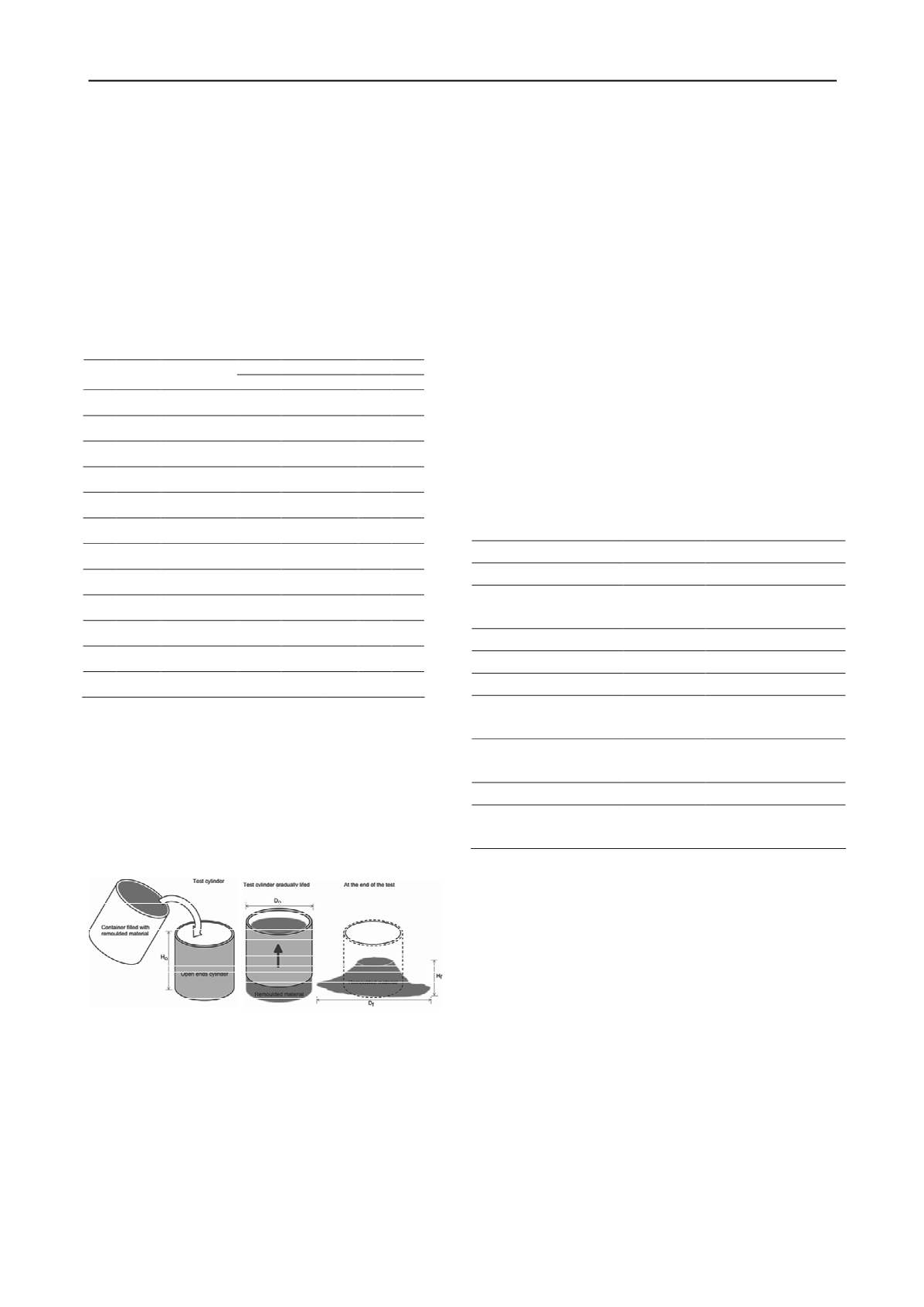
2266
Proceedings of the 18
th
International Conference on Soil Mechanics and Geotechnical Engineering, Paris 2013
determining
wp
has a significant drawback as it can easily be
biased by subjective judgement. Also,
c
ur
is usually measured
using the fall-cone test, a point based measurement system,
which may not necessarily be representative of a large soil
volume.
Keeping this in view this paper proposes a new test
procedure, the quickness test, to evaluate the flow slide
potential of sensitive clays. In contrast to the convential
c
ur
and
I
L
based approaches, the quickness test is a soil volume based
approach and has an added advantage of qualitative description
that provides provide a better visualisation with respect to
understanding of flow slides.
Table 1 Selected large landslides in Norwegian sensitive clays.
L
R
c
ur
S
t
I
L
I
P
No. Year
Landslide [m]
[kPa]
[-] [-] [%]
1 2012 Byneset
300 0.12 120 3.8 4.8
2 2010 Lyngen
230 0.35 50 1.5 12
3 2009 Kattmarka 300 0.24 63 2.9 8
4 1978 Rissa
1200 0.24 100 2.2 6
5 1974 Baastad
930 0.53 35 1.8 8
6 1967 Hekseberg 230 0.25 100 2.4 4
7 1965 Selnes
700 0.35 100 2.3 7
8 1959 Furre
215 0.2 85 1.3 6
9 1953 Bekkelaget
145 0.2 130 2.4 9
10 1953 Borgen
165 0.7 100 1.2 20
11 1953 Ullensaker
250 0.35 42 1.9 6.7
12 1893 Verdalen
2000 0.2 300 2.2 5
*
L
R
= Retrogression distance
2 THE QUICKNESS APPROACH
In this section, a simple test known as the quickness test is
presented. The quickness test aims to provide the basis for a
physical understanding of flow behaviour of fully remoulded
sensitive clays using a new type of geotechnical engineering
test. Additional description on the test methodology can be
referred to Thakur and Degago (2012).
Figure 1. Quickness test procedure (Thakur and Degago, 2012).
2.1 Test procedure
The quickness test is a simple procedure that is performed by
filling an open ended cylinder with remoulded sensitive clay,
then slowly lifting the cylinder, and finally measuring the
deformation (height and lateral spreading) as the material is
subjected to flow due to its own weight. The test concept is
similar to the slump test for concrete that is used to measure the
consistency of freshly mixed concrete. Two different cylinder
sizes were used. The dimensions were the diameter (
D
o
) = 65
mm and height (
H
o
) = 45 mm for the small cylinder, and
D
o
=
100 mm and
H
o
= 120 mm for the large cylinder. The large
cylinder has the same size as the cylinder used for the standard
proctor tests. Figure 1, taken from Thakur and Degago (2012),
shows the concept of the proposed quickness test. The
thoroughly remoulded material is placed into the cylinder,
levelled off, and allowed to flow outward as the cylinder is
slowly lifted upward with minimum disturbance to the sample.
The difference in height between the cylinder and the slumped
material (
H
o
-H
f
) is measured. The outward flow spread diameter
(
D
f
) is also noted. The quickness (
Q
) in % is defined as [1-
H
f
/H
o
] × 100.
2.2 The tested material
Quickness tests were performed on several sensitive clay
samples taken from three different locations in the central
Norway. One of the landslides, Lersbekken, have been studied
and presented in Thakur and Degago (2012). In this work a
similar approach is presented for two new landslide locations
Byneset and Olsøy. These sites have been studied extensively in
connection to landslide hazards. Laboratory index properties of
the sampled material are presented in Table 2. Liquid limit (
w
L
),
c
ui
and
c
ur
of the tested material were obtained using the fall-
cone method as described by the National Standard NS 8015 in
Norway.
Table 2 Properties of the tested materials from three different
landslide locations
Properties
Lersbekken Byneset
Olsøy
Sampling depth (
H
) [m]
6 – 10 4 – 12
4 – 15
Clay fractions (< 2 µm)
[%]
30
30 – 55
50 – 65
Water content (
w
) [%]
22 – 34 27 – 48
28 – 38
Plasticity index (
I
P
) [%]
5 – 7 3 – 15
3 – 10
Liquidity index (
I
L
) [-]
0.7 – 2.0 0.9 – 5.4 0.6 – 3
Undisturbed undrained
shear strength (
c
ui
) [kPa]
12 – 58 5.2 – 72
60 – 100
Remoulded undrained
shear strength (
c
ur
) [kPa]
0 – 2 0 – 3
0 – 2.1
Sensitivity (
S
t
) [-]
16 – 29
4 – 400
30 – 100
Over consolidation ratio
(
OCR
) [-]
1.8 – 2.0 1.1 – 3.3
2
–
4
3 TEST RESULTS AND OBSERVATIONS
Quickness tests were performed on more than 60 different
samples extracted from Lersbekken, Byneset and Olsøy
landslide locations. A series of pictures taken during the
quickness test on two Byneset clay samples, with
c
ur
= 0.1 kPa
and
c
ur
= 1.0 kPa, are shown in Fig. 2. The figure shows slump
and spread observed at selected stages of the tests given as the
precent ratio of the height lifted to the cylinder height (H
o
).
Previous observations during a quickness test conducted on
Lersbekken clay showed that sensitive clays with
c
ur
≈ 0.5 kPa
were not as fluid as they were originally assumed and sensitive
clays with 0.5 kPa <
c
ur
< 1.0 kPa were semisolid in nature
(Thakur and Degago, 20120). In line with this observations, the
Byneset and Olsøy clay samples with
c
ur
< 0.2 kPa, seemed to
be more like a soup as reported by Mitchell and Soga (2004).
The registered collapse of the remoulded material was
negligible when the remoulded sensitive clay had
c
ur
> 1.0 kPa.


